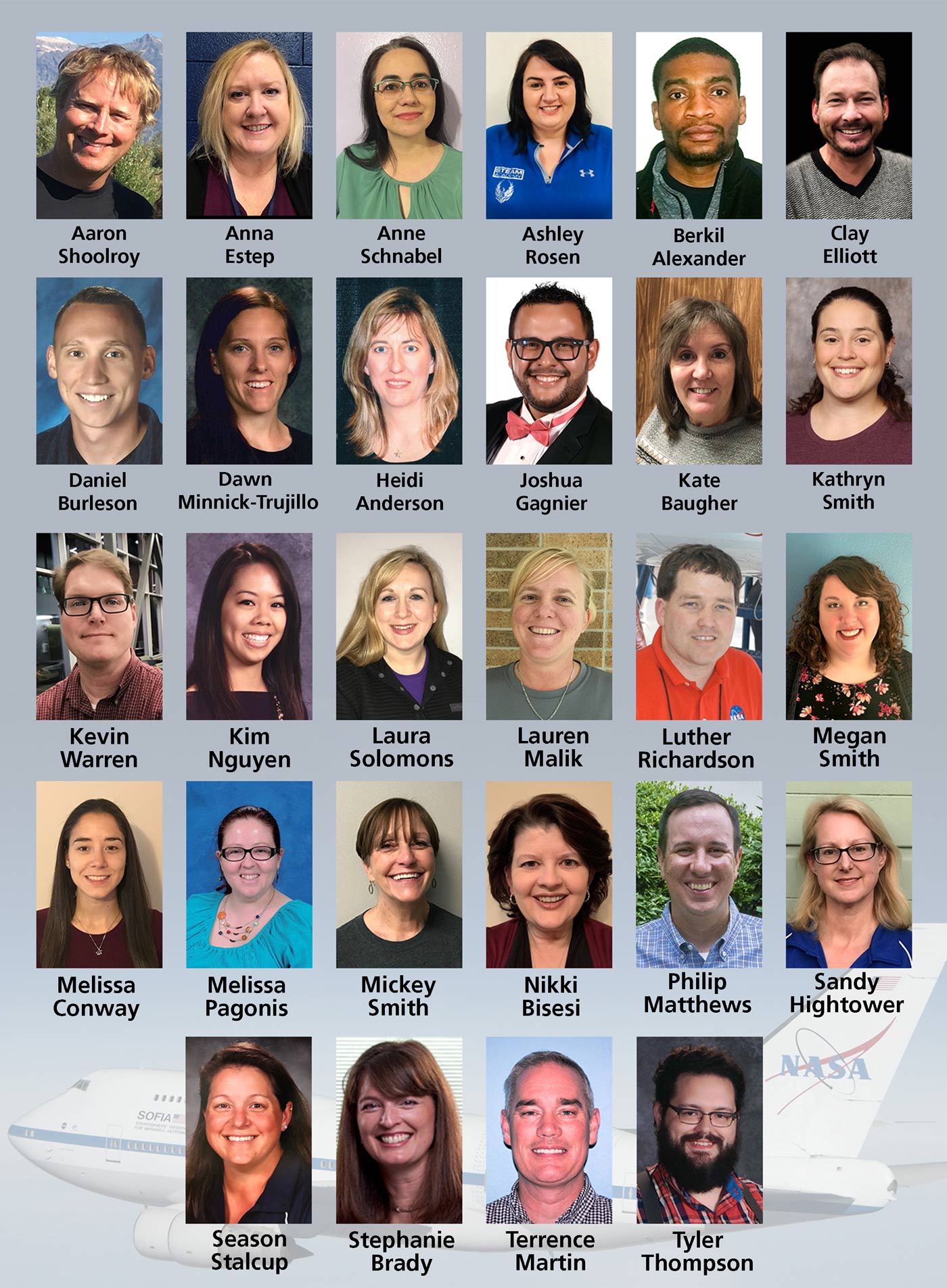A professional development opportunity for high school science teachers designed to improve science teaching and learning and increase student STEM engagement.

February 26, 2019, Mountain View, CA -- The SETI Institute has partnered with 14 school districts in eight states for the 2019 NASA Airborne Astronomy Ambassadors (AAA) program. The AAA program is a professional development opportunity for high school science teachers designed to improve science teaching & learning and increase student STEM engagement. The SETI Institute has managed the AAA program since its inception in 2011.
AAA participant teachers receive training in astrophysics and planetary science, content, and pedagogy. Their training includes a week-long immersion experience at NASA’s Armstrong Flight Research Center Hangar 703 in Palmdale, California, with participation in research flights onboard NASA’s Stratospheric Observatory for Infrared Astronomy (SOFIA). The program culminates in classroom delivery of a SOFIA science-oriented curriculum module. Impact on student STEM learning & engagement will be measured by WestEd education evaluators.
SOFIA is a highly modified Boeing 747SP airliner fitted with a 2.7-meter (106-inch) telescope and using a suite of seven cameras & spectrographs to study celestial objects at infrared wavelengths. SOFIA operates during 10-hour overnight science missions at altitudes between 39,000 and 45,000 feet (12-14 kilometers), above more than 99 percent of the water vapor in Earth’s atmosphere that blocks infrared light from reaching ground-based observatories.
“NASA’s SOFIA observatory provides a fantastic opportunity for teachers to better understand and appreciate the research process by interacting with scientists and mission crew members,” said Dr. Dana Backman, AAA program Principal Investigator. “The teachers can then take what they learn back to their classrooms, schools, and school districts, conveying the value of scientific research and adding real-world content to high school learning environments. The AAA's first-hand experiences also can illuminate the wide variety of STEM career paths available to students.”
The school districts participating in the 2019 Airborne Astronomy Ambassadors program are:
- Anaheim Union High School District, California
- Clark County School District, Nevada
- Cobb County Schools, Georgia
- School District Five of Lexington and Richland Counties, South Carolina
- Fayette County Public Schools, Kentucky
- Harmony Public Schools, Texas
- William S. Hart Union High School District, California
- Manteca Unified School District, California
- Muscogee County School District, Georgia
- Norman Public School District, Oklahoma
- Northside Independent School District (San Antonio), Texas
- Santa Ana Unified School District, California
- Washoe County School District, Nevada
The 28 teachers selected from partner districts as 2019 Airborne Astronomy Ambassadors are listed and pictured below:

- Berkil Alexander, Kennesaw Mountain High School, Kennesaw, Georgia
- Heidi Anderson, Locust Trace AgriScience Center, Lexington, Kentucky
- Kathryn Baugher, Norman North High School, Norman, Oklahoma
- Nikki Bisesi, Hillgrove High School, Powder Springs, Georgia
- Stephanie Brady, Norman High School, Norman, Oklahoma
- Daniel Burleson, Rancho High School, Las Vegas, Nevada
- Melissa Conway, Spring Hill High School, Chapin, South Carolina
- Clay Elliott, Oxford Academy, Anaheim, California
- Anna Estep, Chapin High School, Chapin, South Carolina
- Joshua Gagnier, Santa Ana High School, Santa Ana, California
- Sandra Hightower, Century High School, Santa Ana, California
- Lauren Malik, William Howard Taft High School, San Antonio, Texas
- Terrence Martin, William Howard Taft High School, San Antonio, Texas
- Philip Matthews, Kennesaw Mountain High School, Kennesaw, Georgia
- Dawn Minnick-Trujillo, Las Vegas Academy of the Arts, Las Vegas, Nevada
- Kim Nguyen, Oxford Academy, Anaheim, California
- Melissa Pagonis, John Paul Stevens High School, San Antonio, Texas
- Luther Richardson, Columbus High School, Columbus, Georgia
- Ashley Rosen, STEAM Academy, Lexington, Kentucky
- Anne Schnabel, Tom C. Clark High School, San Antonio, Texas
- Aaron Shoolroy, Reno High School, Reno, Nevada
- Kathryn Smith, William S. Hart High School, Santa Clarita, California
- Megan Smith, Lathrop High School, Manteca, California
- Mickey Smith, Earl Wooster High School, Reno, Nevada
- Laura Solomons, Columbus High School, Columbus, Georgia
- Season Stalcup, Wheeler High School, Marietta, Georgia
- Tyler Thompson, West Career and Technical Academy, Las Vegas, Nevada
- Kevin Warren, Norman North High School, Norman, Oklahoma


(Figure 2) A group of Airborne Astronomy Ambassadors plus their flight facilitator at the educators’ console onboard SOFIA. (NASA)
View/Download Full Press Release HERE.
About the Airborne Astronomy Ambassador Program
The SETI Institute’s NASA Airborne Astronomy Ambassador Program was one of the 27 organizations from across the United States selected by NASA for cooperative agreement awards to implement a new strategic approach to more effectively engage learners of all ages on NASA science education programs and activities. Selections were made by the agency's Science Mission Directorate (SMD) in Washington, DC, through the Science Education Cooperative Agreement Notice. Selectee activities will support Earth science, astrophysics, planetary science, and heliophysics. AAA is funded by NASA SMD NNX16AC51A .
About the SETI Institute
Founded in 1984, the SETI Institute is a non-profit, multi-disciplinary research and education organization whose mission is to lead humanity’s quest to understand the origins and prevalence of life and intelligence in the Universe and to share that knowledge with the world. Our research encompasses the physical and biological sciences and leverages expertise in data analytics, machine learning and advanced signal detection technologies. The SETI Institute is a distinguished research partner for industry, academia and government agencies, including NASA and NSF.
Contact information
Rebecca McDonald
Director of Communications
SETI Institute
rmcdonald@seti.org
Dana Backman
AAA Principal Investigator
SETI Institute
dbackman@seti.org





